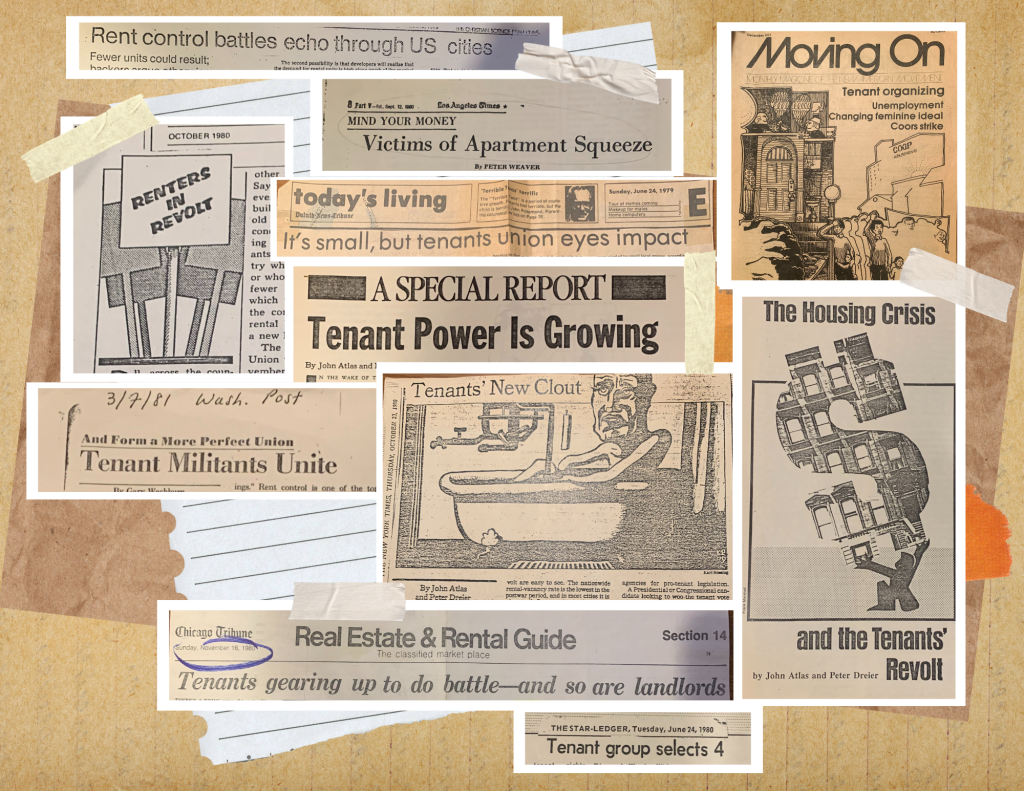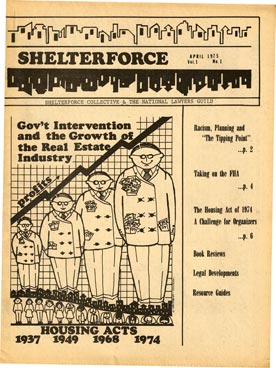
A collage of news headlines and cartoons from the early days of the tenants movement. Photo courtesy of John Atlas
During the past year, the tenants’ movement has suffered major setbacks. Landlords in California and Massachusetts, once strongholds of tenant activism, succeeded in wiping out rent controls. In New York City, rent regulations have been weakened. Even in New Jersey, the capital of renters’ rights, tenant organizations are in a holding strategy, trying to keep what they won during the past two decades. More and more states have enacted laws preempting local tenant protections. It wasn’t always so.
Twenty years ago the nation’s first tenants’ newspaper, Shelterforce, was born, just as the “tenants’ movement” was picking up steam in the aftershock of the civil rights movement. It was a time of excitement and history making. The organizers, leaders, and activists shared a view that the fight for renters’ rights was part of a larger democratization of our society.
The day-to-day struggles – fighting for better code enforcement, blocking evictions, organizing rent strikes, working for rent control, halting condo conversions, exposing arson-for-profit – took on a larger meaning because they were seen as stepping stones to more significant social, political, and economic change. Because tenants were disproportionately poor, minority, and women, the fight for tenants’ rights was a way to empower America’s most disenfranchised citizens.
During the l970s and early l980s, many of us viewed tenants as the “sleeping giant” of American politics. As the rental housing market tightened, and as homeownership became even more elusive for working people, tenants with their backs to the wall responded with an upsurge of activism in cities across the country.
At the time, the “objective conditions” clearly were ripe for a new wave of tenant organizing. But something else was needed to trigger this explosion of activism: political will. Political activists made decisions about how to invest their time and talent. They made a “leap of faith” to get involved with tenant organizing
Tenant activists often began by organizing residents of a single building or complex. They learned the nuts and bolts of tenant organizing and helped build strong organizations by identifying and developing leaders, forming committees, raising money from churches or foundations, as well as members, and forging alliances with sympathetic politicians or government bureaucrats.
Then, groups working in one neighborhood joined forces with those in other neighborhoods to forge citywide alliances. Many statewide tenant groups emerged. Efforts to form a national tenant organization were never fully realized, but Shelterforce helped sponsor a number of national conferences at which tenant activists shared ideas and information that helped keep the momentum going. Indeed, Shelterforce itself became the unifying force in building a national tenant movement, even without a single umbrella organization.
A Multi-Sided Movement
Since the 1960s, we’ve actually had three parallel tenant movements. One was based in public housing, another in subsidized developments, and a third in private housing.
During the past decade, tenant activism in both public housing and subsidized housing (i.e. Section 8 developments) has gained in numbers and strength. Conservatives, seeking ways to remove the government from the housing subsidy business, used the rhetoric of “tenant empowerment” to advance their agenda to privatize government-subsidized housing developments. But tenant groups turned this rhetoric to their advantage and developed a new infrastructure of resident organizations. They pressured Congress to enact laws giving residents a stronger voice in day-to-day management and, in some cases, ownership of their developments. Federal HOPE funds have been used to help mobilize tenants and hire staff. As a result, some of the best grassroots organizing today is taking place among the tenants in public and subsidized housing.
But tenants in public or subsidized housing, or with Section 8 vouchers, represent a tiny fraction of all renters. Unfortunately, the tenants movement among residents of unsubsidized private apartment buildings has not kept up momentum. This group comprises more than 90 percent of all the nation’s renters, including some of the nation’s poorest people in some of its most substandard housing. They are most vulnerable to market forces and have the fewest rights. The tenants’ movement must renew its commitment to organize these tenants.
Shifting Trends
What factors contributed to the decline of tenant organizing in the private housing market?
First, during the past decade, major foundations (with a few exceptions) have shifted their priorities toward community development and away from grassroots organizing. Some tenants groups have become nonprofit developers, helping tenants form co-ops or CDCs to stabilize their neighborhoods. While organizing and development are not incompatible, when funders emphasize bricks-and-mortar, it is often difficult to sustain grassroots mobilization.
Second, the conservative push to “defund the left” has taken its toll. During the late l970s and early l980s, many local tenant groups were supported by federal CETA and VISTA funds. These programs were quickly eliminated by the Reagan Administration. At the same time, legal services – one of the tenant movement’s key allies – saw its budget slashed, and overseers warned these federally funded attorneys to avoid “political action.” This made many local legal services agencies gun-shy about working with organized tenant groups.
Third, landlords were better organized. Groups such as the National Multi-Housing Council helped local landlord groups devise new approaches and refine old techniques (including massive campaign contributions to local, state, and federal officials) to fighting tenants’ rights. They were aided by the growing anti-government fervor fostered by right-wing groups and think tanks, like the Heritage Foundation and the American Enterprise Institute, and by the Reagan and Bush Administrations. These forces undermined support for government activism to solve social and economic problems with measures like rent control. This put tenant groups on the defensive, constantly fighting attempts in Congress and state legislatures to pre-empt local rent control.
Fourth, as homelessness exploded during the past decade, many Americans working on the front lines of the housing crisis focused on the immediate survival needs of the homeless. Some started soup kitchens or shelters; some formed public interest coalitions to demand federal, state, and local funds for basic services or to stop governments, police, or businesses from harassing the homeless. While this work was necessary, it diverted attention and resources away from tenant organizing and from building strong, permanent organizations that could fight for structural reforms in the housing market.
The wave of condominium conversions during the l980s also undermined tenant activism. Conversions not only deplete rental housing stock but turn apartment buildings with single owners into condo buildings with multiple owners, who may rent out their individual units, but have no stake in the buildings’ other units.
Finally, the threat to federally-subsidized developments catalyzed tenant activists in these projects. Dozens of reports during the past decade warned about the potential loss of publicly-funded housing – a concern heightened by current moves in Congress to eliminate HUD and/or privatize existing developments. While tenants in public housing are often at odds with local housing authorities, both have a stake in protecting federal funding of their developments. Tenants in federally-assisted developments may organize against their landlords to improve security and other conditions, but both residents and owners have a stake in persuading Congress to maintain appropriations. National housing groups, like the National Low Income Housing Coalition, may not always see eye-to-eye with the lobbyists for the National MultiHousing Council, but they join forces to keep Washington in the subsidized housing business.
The Challenges In Private Housing Organizing
Organizing tenants in private housing is often more difficult than in subsidized developments. The targets are more elusive. Buildings are more likely to change hands. As local governments face deeper and deeper fiscal crises, it becomes even harder for tenant organizations to compel city agencies to enforce local health and safety laws. Owners go bankrupt or abandon their buildings. City governments that assume control often lack the resources, or will, to maintain the buildings or sell them to nonprofits or tenant groups.
Organizing in private slum housing has also become more difficult, due to conditions such as the rise in homelessness, the deterioration of inner-cities, the drug epidemic, and the prevalence of gangs and violence.
The wedge between the poor and middle class, so skillfully placed by the demagogues of the right, has significantly contributed to our inability to create a broad-based movement throughout the renter community – a movement of the bottom half of the population joining forces against the common sources of their problems.
Nonetheless, much good organizing is still taking place in private housing around the country. But much more is needed to grapple with the problems facing private tenants. We need to reinvigorate the tenants movement with a new dose of grassroots organizing and a new generation of young activists. We need to find new allies among churches, foundations, and sympathetic politicians. We must convince multi-issue community organizations to incorporate tenants’ concerns into their agendas in low-income and working-class neighborhoods.
The tenants’ movement must also be more involved politically, helping to make housing a “win or lose” issue for candidates. Tenant groups need to hold candidates forums. They need to register and mobilize tenants to vote and work on political campaigns. Tenant groups also should join progressive coalitions working to elect activists to public office – and hold them accountable once elected.
Next Steps for Tenant Activists
Perhaps it is time for a national conference of tenant activists to help the movement regroup, rethink, and re-energize. There’s lots to discuss, including nuts and bolts of organizing, leadership development, fundraising, and tactics and strategies. We need to devise new ways to challenge the current wave of conservative local officials – mayors and city council members – with a housing policy hostile to renters. We need to discuss ways to join forces with other progressives on the local, state, and national levels. We have to discuss the current attack on federal housing programs and the distorted priorities that provide wealthy homeowners with more subsidies than working poor tenants.
Finally, it is time to push for a National Tenant-Landlord Relations Act (NTLRA) to provide tenants in public housing, HUD-assisted developments, and private housing with a vehicle similar to the National Labor Relations Act. To become recognized as the legitimate voice of a group of residents, tenant groups would have to win, in an election supervised by a federal agency, a majority of the residents’ votes in that development. Tenants and landlords would bargain over rents, building conditions, evictions, and other standards. A NTLRA could become the catalyst for a new wave of tenant activism.
One of the most promising developments that tenant activists can look to is the recent reinvigoration of the labor movement. After several decades of decline, union membership has inched up, thanks to organizing among low-wage employees, such as janitors, clerical workers, nursing home workers, hotel workers, and others. Successful organizing drives have allied unions with church and community groups. Unions that have made the most headway in recruiting have drawn on themes and tactics from civil rights crusades and grassroots organizing campaigns. The AFL-CIO’s new president, John Sweeney, has pledged new resources to train and hire union organizers and rekindle a spirit of militant unionism, focusing partly on minorities, women, immigrants, and tenants.
The tenants and union movements need to work together. As we face the right wing onslaught, we should recall that political and economic reform require people to mobilize, organize, and protest. The attacks on the working poor, welfare recipients, people of color, and women – these are attacks on tenants, most of whom live in private housing.
There are many ways to organize people, but a key part of any strategy is, literally, to organize people where they live.




Comments